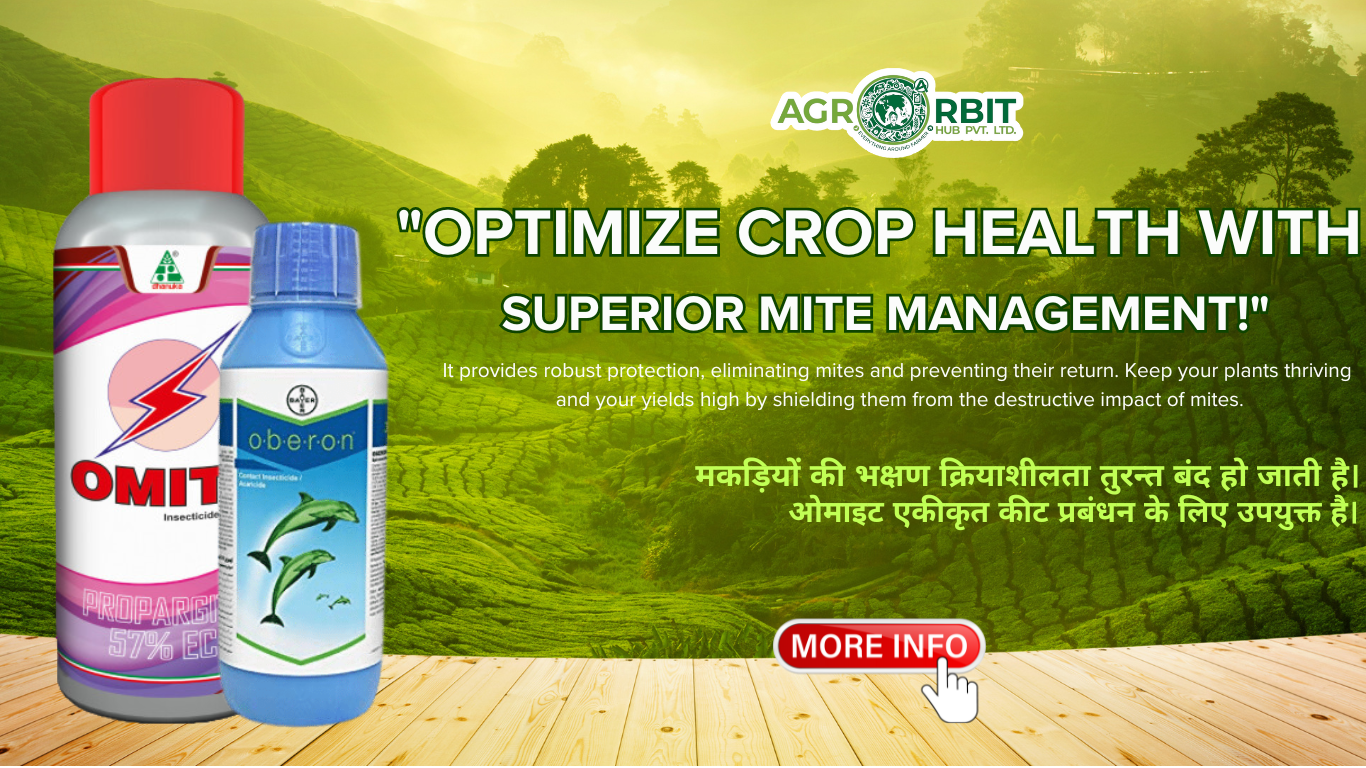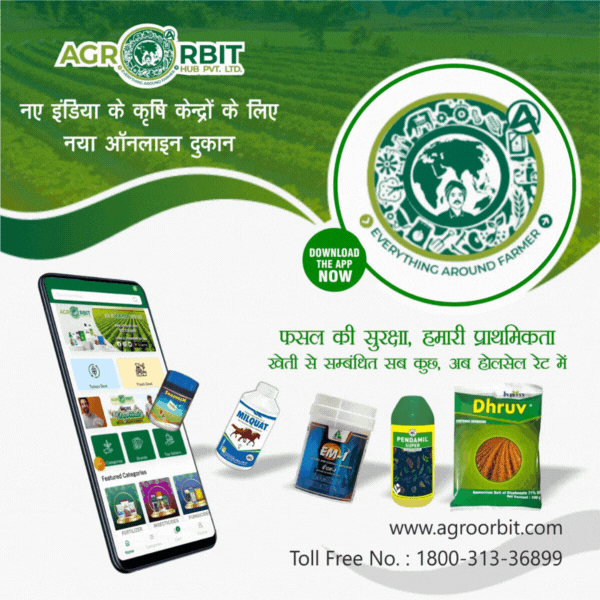

Mite Control is Vital for Sustainable Farming - Safeguard Your Yields and Secure Your Future
Comprehensive Strategies for Effective Mite Management on Crops:
Integrating Cultural, Biological, and Chemical Controls
An ounce of prevention is worth a pound of cure
Introduction
Mites are tiny, yet formidable
pests that can wreak havoc on a wide range of crops, leading to significant
reductions in yield and quality. Their rapid reproductive cycles and ability to
thrive in various environmental conditions make them particularly challenging
to manage. Effective management of mites requires a comprehensive approach that
integrates cultural, biological, and chemical strategies. By leveraging the
strengths of each method and utilizing advanced crop protection products such
as Omite and Oberon, farmers can maintain healthy crops and ensure sustainable
agricultural practices. This guide delves into the detailed strategies for
managing mite populations on crops, highlighting the importance of Integrated
Pest Management (IPM) and the role of specific miticides in achieving long-term
control.
Effective Management of Mites on Crops
Mites are tiny pests that can
cause significant damage to a variety of crops, leading to reduced yields and
quality. Effective management of mites involves a combination of cultural,
biological, and chemical strategies. Here’s a comprehensive guide to managing
mites on crops, incorporating the use of crop protection products such as Omite
and Oberon.
1. Cultural Control
Cultural practices are the
first line of defence against mite infestations. These practices include:
- Crop Rotation:
Rotating crops can help break the life cycle of mites. Different crops can
disrupt the feeding and reproduction cycles of mites, making it harder for
them to establish and proliferate. For example, rotating from a crop
susceptible to mite infestations, like beans, to a less susceptible one,
like corn, can significantly reduce mite populations.
- Sanitation:
Removing plant debris and weeds that can harbour mites is crucial. Mites
often overwinter in plant residues, so cleaning up these materials can
reduce their breeding grounds. Regularly cleaning equipment and tools to
remove any mite eggs or larvae also helps in reducing the risk of
spreading infestations.
- Proper Irrigation:
Maintaining adequate moisture levels can reduce mite populations, as they
thrive in dry conditions. Overhead irrigation can help wash mites off
plants, but care must be taken to avoid creating overly humid conditions
that might Favor other pests and diseases. Ensuring proper soil moisture
can also support plant health, making them less susceptible to mite
damage.
- Use of Resistant Varieties:
Planting mite resistant crop varieties can significantly reduce
infestations. These varieties have been bred to possess traits that make
them less appealing or more resilient to mite attacks. For instance, some
soybean varieties have hairy leaves that can deter mite feeding, while
certain tomato varieties might produce chemicals that are toxic to mites¹.
2. Biological Control
Biological control involves
using natural predators and parasites to manage mite populations. Some
effective biological control agents include:
- Predatory Mites:
Species such as Phytoseiulus persimilis and Amblyseius swirskii
feed on harmful mites. These predatory mites are highly effective at
controlling spider mites and other pest mites. Phytoseiulus persimilis
is particularly effective in humid conditions and can consume large
numbers of spider mites daily. Amblyseius swirskii is versatile and
can also feed on pollen and small insects, making it useful in a broader
range of conditions.
- Insect Predators:
Lady beetles (both adults and larvae) and lacewings are known to prey on
mites. Lady beetles, such as the convergent lady beetle (Hippodamia
convergens), are effective in controlling aphids, mites, and other
small insects. Lacewing larvae, known as "aphid lions," are
voracious predators that can consume significant numbers of mites in a
short period. These beneficial insects can be introduced into fields or
encouraged by planting flowering plants that provide nectar and pollen.
- Entomopathogenic Fungi:
Fungi like Beauveria bassiana can infect and kill mites. These
fungi act as natural pathogens that infect mites through their cuticles,
eventually killing them. Beauveria bassiana spores germinate on the
mite's body, penetrate the exoskeleton, and proliferate inside, leading to
the mite's death. This method is particularly useful in humid environments
where the fungi can thrive. Formulations of these fungi can be applied as
sprays, providing a biological control method that integrates well with
other IPM strategies
3.Chemical
Control
Chemical
control should be used as a last resort and integrated with other management
practices to avoid resistance development. Key points include:
- Selective Miticides:
Use miticides that specifically target mites without harming beneficial
insects. This approach helps preserve natural predators and parasitoids
that can aid in controlling mite populations. For example, selective
miticides like Omite and Oberon are designed to target mites while
minimizing impact on nontarget species.
- Rotation of Chemicals:
Rotate different classes of miticides to prevent resistance. Mites can
quickly develop resistance to chemical treatments if the same miticide is
used repeatedly. Rotating between different chemical classes, such as
organophosphates, carbamates, and pyrethroids, can help mitigate this risk
and maintain the effectiveness of chemical controls.
- Application Timing: Apply chemicals during early stages of infestation for maximum effectiveness. Early intervention can prevent mites from establishing large populations and causing significant damage. Regular monitoring and timely application of miticides can help keep mite populations under control.

Omite
(Propargite)
Omite is a
contact acaricide known for its efficacy against a broad spectrum of mite
species. It is particularly valued for its quick knockdown effect and long-lasting
control. Here's an in-depth look at Omite:
Chemical
Composition and Mode of Action:
- Active Ingredient:
Propargite.
- Mode of Action:
Omite
operates as a contact acaricide, meaning it requires direct contact with
the mites to be effective. Propargite disrupts the normal functions of
mite nervous systems, leading to paralysis and eventual death. It affects
the respiration of mites by inhibiting mitochondrial ATP synthesis, which
is crucial for energy production in cells.
Application
and Efficacy:
- Crops:
1.
Cotton:
Targeted
Mites: Omite is highly effective against the two spotted spider mite
(Tetranychus urticae) and the red spider mite (Tetranychus cinnabarinus).
Efficiency:
Quick Knockdown: Provides rapid
reduction in mite populations.
Residual Control:
Continues to protect for an extended period, reducing the need for frequent
applications.
Yield Improvement: By
controlling mite infestations effectively, Omite helps in maintaining the
health of the cotton plants, leading to higher yields and better quality Fibers.
2.
Fruits (Apples and Citrus):
Targeted
Mites: Omite controls European red mite (Panonychus ulmi), citrus
red mite (Panonychus citri), and the two spotted spider mite (Tetranychus
urticae).
Efficiency:
Enhanced Fruit Quality:
Effective mite control results in healthier fruit with fewer blemishes and
higher market value.
Extended Protection: The
residual action of Omite ensures long-lasting control, protecting fruit crops
throughout critical growth stages.
Reduced Damage: Prevents leaf damage
and defoliation, maintaining overall plant Vigor and productivity.
3.
Vegetables (Tomatoes and Cucumbers):
Targeted
Mites: Controls the two spotted spider mite (Tetranychus urticae)
and other pest mites.
Efficiency:
Healthy Foliage:
Maintains healthy leaves essential for photosynthesis, leading to robust plant
growth and higher yields.
Consistent Control: The contact action
ensures immediate knockdown of mites present on the foliage.
Quality Produce: Reduces the risk of mite
induced deformities and discoloration on fruits and vegetables, ensuring better
quality produce.
4.
Ornamental Plants:
Targeted
Mites: Controls a variety of mite species affecting ornamental
plants, including spider mites.
Efficiency:
Aesthetic Value: Keeps ornamental
plants free from mite infestations, preserving their aesthetic value and
marketability.
Plant Health: Protects against mite
induced stress, ensuring vigorous growth and vibrant foliage.
- Application Method:
It is typically applied as a foliar spray, ensuring thorough coverage of
the plant's leaves where mites are commonly found. The contact nature of
Omite necessitates that the spray reaches the mites directly.
- Effectiveness:
Omite is especially effective against spider mites, including the
twospotted spider mite (Tetranychus urticae) and the European red
mite (Panonychus ulmi). It provides quick knockdown of mite populations
and offers residual control, reducing the need for frequent applications.
- Advantages:
- Quick Knockdown:
Rapidly reduces mite populations upon contact.
- Residual Control:
Continues to protect crops from mite infestations for an extended period.
- Versatility:
Effective on a wide range of crops, making it a versatile option for many
farmers.
Usage
Recommendations:
- Timing: Apply during
early stages of mite infestation for optimal results.
- Dosage: Follow
manufacturer’s instructions for specific dosage recommendations based on
the crop and mite species.
- Precautions:
Avoid application during peak pollinator activity to minimize impact on
beneficial insects. Use appropriate personal protective equipment (PPE)
during application.
Oberon
(Spiromesifen)
Oberon is
both a systemic and contact miticide, targeting adult mites and their eggs. It
is known for its residual control and effectiveness on various crops. Here's a
detailed examination of Oberon:
Chemical
Composition and Mode of Action:
- Active Ingredient:
Spiromesifen.
- Mode of Action:
Oberon works by inhibiting lipid biosynthesis in mites. Lipids are
essential for the development and reproduction of mites, and by disrupting
this process, Oberon effectively reduces mite populations. This dual
action targets both the adults and the eggs, providing comprehensive
control.
Application
and Efficacy:
- Crops:
1.
Tomatoes:
Targeted Pests: Spider mites (Tetranychus
urticae), whiteflies (Bemisia tabaci), and thrips.
Efficiency:
Systemic and Contact Action:
Oberon’s systemic properties ensure that mites feeding on any part of the plant
are controlled, while its contact action provides immediate knockdown.
Residual Control:
Offers long-lasting protection, reducing the need for frequent applications.
Quality Produce:
Maintains healthy foliage and fruit, leading to higher yields and
better-quality tomatoes.
2.
Peppers:
Targeted Pests:
Spider mites (Tetranychus urticae), broad mites (Polyphagotarsonemus latus), and
whiteflies.
Efficiency:
Comprehensive Coverage: Ensures all
parts of the plant are protected due to its systemic nature.
Effective Control: Reduces mite
populations effectively, preventing damage to leaves and fruits.
Healthy Growth:
Promotes robust plant growth and higher pepper yields.
3.
Cucumbers:
Targeted Pests: Spider mites
(Tetranychus urticae), whiteflies, and thrips.
Efficiency:
Prolonged Protection: Long-lasting
residual control helps maintain healthy cucumber plants.
Effective Knockdown: Immediate
reduction in pest populations upon application.
Enhanced Crop Quality: Ensures high-quality
cucumbers with fewer blemishes and better marketability.
4.
Ornamental Plants:
Targeted Pests: Spider mites,
whiteflies, and thrips.
Efficiency:
Aesthetic Preservation: Keeps
ornamental plants free from mite infestations, preserving their aesthetic
value.
Extended Control: Provides long-lasting
protection, ensuring the health and vigor of ornamental plants.
Versatile Application:
Suitable for a wide variety of ornamental species, enhancing their market
appeal.
- Application Method:
It can be applied as a foliar spray, similar to Omite. The systemic nature
of Oberon allows it to be absorbed by the plant and translocated, ensuring
that mites feeding on any part of the plant are affected.
- Effectiveness:
Oberon is effective against various mite species, including whiteflies and
certain thrips, in addition to spider mites. Its ability to target both
adult mites and eggs ensures a reduction in mite population growth and
prevents future infestations.
- Advantages:
- Residual Control:
Offers long-lasting protection against mites, reducing the frequency of
applications.
- Systemic and Contact Action:
Ensures comprehensive coverage and control, even for mites that are not
directly contacted by the spray.
- Broad Spectrum:
Effective against multiple mite species and other pests like whiteflies.
Usage
Recommendations:
- Timing: Apply when mite
populations are first observed. Repeat applications may be necessary
depending on the level of infestation and crop type.
- Dosage: Adhere to the
manufacturer’s guidelines for dosage, which vary based on the crop and
mite species.
- Precautions:
Ensure proper PPE is worn during application. Avoid spraying during windy
conditions to prevent drift and ensure accurate application.
Integrated
Use of Omite and Oberon in IPM
Both
Omite and Oberon can play crucial roles in an Integrated Pest Management (IPM)
strategy. IPM focuses on combining multiple control methods to manage pest
populations in an economically and ecologically sustainable manner. Here’s how
Omite and Oberon can be integrated into IPM:
- Monitoring and Scouting:
Regularly inspect crops to detect early signs of mite infestations. Use
magnifying lenses or mite traps for accurate monitoring.
- Threshold Levels:
Establish action thresholds to decide when chemical controls are
necessary. For instance, in tomatoes, a threshold might be set at the
presence of 10 mites per leaf.
- Chemical Rotation:
Rotate the use of Omite and Oberon with other miticides to prevent
resistance development. This ensures that mites do not develop resistance
to any single chemical class.
- Biological and Cultural Controls:
Combine chemical treatments with biological controls (such as predatory
mites and entomopathogenic fungi) and cultural practices (such as crop
rotation and proper irrigation) to enhance overall effectiveness.
By
integrating Omite and Oberon with other pest management strategies, farmers can
achieve effective and sustainable control of mite populations, ensuring healthy
crop yields and quality.
Explore
Agro Orbit App
for more product
4.
Integrated Pest Management (IPM)
IPM
combines multiple strategies to manage mite populations sustainably. Key components
of IPM include:
- Monitoring and Scouting:
Regularly inspect crops for signs of mite infestation. Use tools like
magnifying lenses to detect early stage infestations. Monitoring involves
checking both the upper and lower surfaces of leaves, as mites often hide
in these areas. Identifying the presence of mites early can help in taking
timely control measures.
- Threshold Levels:
Implement action thresholds to determine when control measures are
necessary. Action thresholds are specific levels of pest populations at
which control measures should be implemented to prevent economic damage.
These thresholds vary depending on the crop and its susceptibility to mite
damage. For instance, in tomatoes, a threshold might be set at the
presence of 10 mites per leaf before taking action.
- Record Keeping: Maintain detailed records of pest populations and control measures to inform future management decisions. Keeping accurate records helps in tracking the effectiveness of control measures and in making informed decisions about future pest management strategies. Records should include information on pest population levels, environmental conditions, and the timing and type of control measures used.
"Mite Control is Vital for Sustainable Farming - Safeguard Your Yields and Secure Your Future!"
Managing
mite infestations effectively demands a multifaceted approach that combines
cultural practices, biological controls, and judicious use of chemical
treatments. Cultural controls, such as crop rotation, sanitation, and proper
irrigation, form the foundation of a preventive strategy that disrupts mite
life cycles and reduces breeding grounds. Biological control agents, including
predatory mites, insect predators, and entomopathogenic fungi, provide natural
and sustainable means to keep mite populations in check. When chemical control
is necessary, products like Omite and Oberon offer targeted and effective
solutions that minimize harm to beneficial organisms and mitigate the risk of
resistance development.
Omite, with
its quick knockdown and residual control, and Oberon, with its systemic and
contact action against both adult mites and eggs, are pivotal in managing mite
populations. By incorporating these miticides within an IPM framework, farmers
can ensure timely intervention, rotation of chemical classes, and integration
with biological and cultural practices, thereby achieving sustainable and
effective mite control.
The success of mite management hinges on continuous monitoring, adherence to action thresholds, and meticulous recordkeeping. These practices enable informed decisionmaking and adaptive management, ensuring that control measures are both effective and economically viable. Ultimately, the integration of various control strategies fosters a resilient agricultural system capable of sustaining high crop yields and quality, even in the face of persistent mite challenges.







